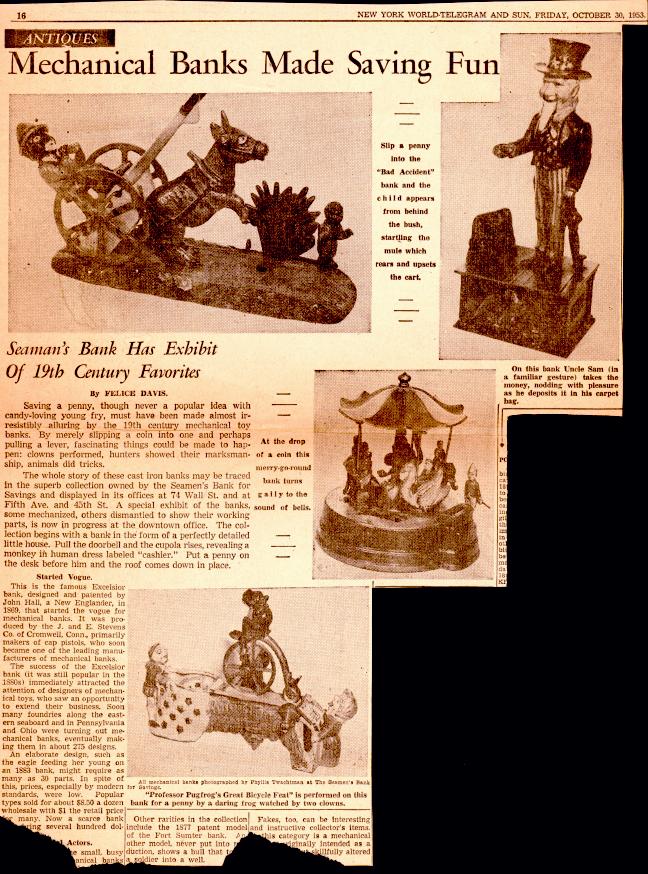| NEW YORK WORLD-TELEGRAM AND SUN, FRIDAY, OCTOBER 30,
1953 ANTIQUES Mechanical Banks Made Saving Fun Seamen's Bank Has Exhibit Of 19th Century Favorites By Felice Davis Saving a penny, though never a popular idea with candy-loving young fry, must have been made almost irresistibly alluring by the 19th century mechanical toy banks. By merely slipping a coin into one and perhaps pulling a lever, fascinating things could be made to happen: clowns performed, hunters showed their marksmanship, animals did tricks. The whole story of these cast iron banks may be traced in the superb collection owned by the Seamen's Bank for Savings and displayed in its offices at 74 Wall St. and at Fifth Ave. and 45th St. A special exhibit of the banks, some mechanical, others dismantled to show their working parts, is now in progress at the downtown office. The collection begins with a bank in the form of a perfectly detailed little house. Pull the doorbell and the cupola rises, revealing a monkey in human dress labeled "cashier." Put a penny on the desk before him and the roof comes down in place. Started Vogue. This is the famous Excelsior bank, designed and patented by John Hall, a New Englander, in 1869, that started the vogue for mechanical banks. It was produced by the J. and E. Stevens Co. of Cromwell, Conn., Primarily makers of cap pistols, who soon became one of the leading manufacturers of mechanical banks. The success of the Excelsior bank (it was still popular in the 1880s) immediately attracted the attention of designers of mechanical toys, who saw an opportunity to extend their business. Soon many foundries along the eastern seaboard and in Pennsylvania and Ohio were turning out mechanical banks, eventually making them in about 275 designs. An elaborate design, such as the eagle feeding her young on an 1883 bank, might require as many as 30 parts. In spite of this, prices, especially by modern standards, were low. Popular types sold for about $8.50 a dozen wholesale with $1 the retail price for many. Now a scarce bank?????ring several hundred dol-????? ??????? Actors ???e small, busy ?????anical banks Other rarities in the collection include the 1877 patent model of the Fort Sumter bank. Another model, never put into production shows a bull that ???a soldier into a well. Fakes, too, can be interesting and instructive collector's items. In this category is a mechanical bank originally intended as a ??????? skillfully altered????? Photo captions — Slip a penny into the "Bad Accident" bank and the child appears from behind the bush, startling the mule which rears and upsets the cart. On this bank Uncle Sam (in a familiar gesture) takes the money, nodding with pleasure as he deposits it in his carpet bag. At the drop of a coin this merry-go-round bank turns gaily to the sound of bells. "Professor Pugfrog's Great Bicycle Feat" is performed on this bank for a penny by a darling frog watched by two clowns. All mechanical banks photographed by Phyllis Twachtman at The Seamen's Bank for Savings.
|

